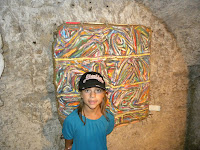











Nook of Naples: Puozza scula (May you drain away) is a Neapolitan expression that wishes death upon one's enemies. The saying derives from the macabre burial practices of the seventeenth century Dominicans who painted brightly colored frescoes beside the crypts of wealthy patrons -- and used their skulls for decoration.
The Church of Santa Maria della Sanita doesn't seem to be much on the map of tourist attractions. Taking a walk down Via Capodimonte, the top of the basilica peeks out from the traffic-frenzied bridge. An elevator along the sidewalk takes me down to the road below. From there, I walk less than a block and into a church filled with modern architecture and art. From one angle, the front altar doesn't seem to be there. From another, translucent green angels look as if they are ready to fly away.
Beyond the altar, an immense gate leads to the spooky remnants of an old basilica. A barely noticeable passage with no door beckons me to enter the catacombs. Immediately in front of me sparkles San Gaudioso's niche with the remains of blue tiles from the original Basilica erected in the 5th century.
Saint Gaudioso was a bishop from Abitina, a village near Carthage. He fled North Africa during the Christian persecutions and arrived in Naples on a leaky boat. He went on to establish himself on what was then the acropolis of Naples. Among other things, he preserved the relics of several saints, notably Saint Restituta. (My next odious woman.)
Adjacent to San Gaudioso's niche, a stunning fresco of Saint Catherine of Siena still remains on a wall in the Nostriano niche, so called because it's believed to be the burial place of Bishop Nostriano who welcomed San Gaudioso and his other African exiles.
The Basilica eventually flooded and mud covered it entirely for many hundreds of years. In the 1600's Dominican monks dug up the church and turned it into a burial place. To respect their patrons, they created frescoes of the deceased, embedding their skulls into the walls as well as their bones and spines. Today, I can still make out the faded images of people and how they might of looked during their lifetime, wearing skirts and capes. There are also explanatory notes indicating the social status of the person.
Beyond the wealthy crypts, an array of dirt-floor rooms contain carved niches against the walls. In one room, a rectangular hole at the top of the ceiling indicates that the bodies were brought down by pulley. The bones were then broken so the corpse could be put into a tight fetal position, which was believed to help bring the dead back to the Father. The body was put inside the niche and, often, three holes were punctured into the stomach, particularly if a family wanted this space for more than one of their loved ones. The stomach acids and other liquids in the body ran down and into the shelled out bottom of the niche, helping it decompose more quickly.
At the far end of the catacombs, the Dominicans created a cemetery in what had once been an ancient Roman cistern. Interestingly, throughout the church and also within the catacombs and the cistern, modern art pieces are on display, fusing the ancient, Byzantine, Renaissance, and modern together.
Catacomb travel tip -- these echoing caverns provide a wonderful opportunity to practice cackling.
Hours of operation: Every day from 9:00am - 12:30pm.
No comments:
Post a Comment